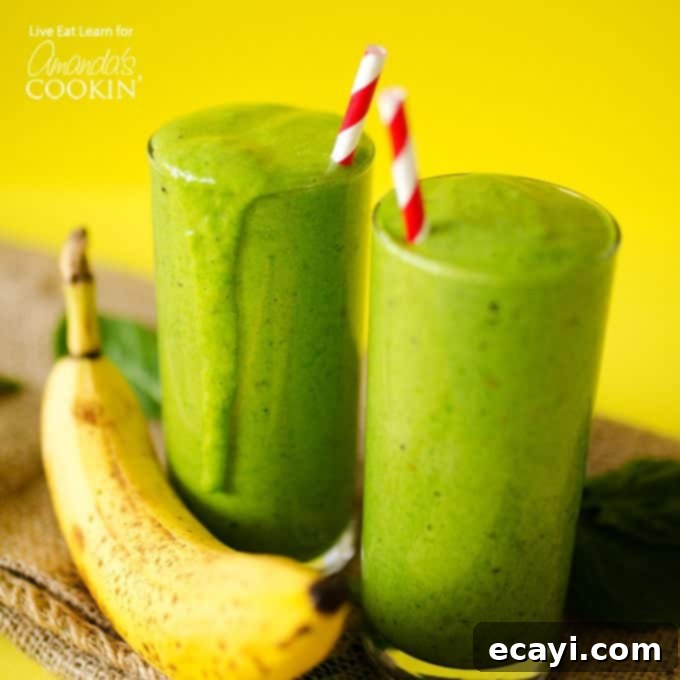The Ultimate Guide to Easy & Delicious Green Smoothies: Boost Your Health with Simple Recipes
Have you ever considered adding green smoothies to your daily routine but felt unsure where to begin? Today, we’re diving deep into the world of green smoothies, providing you with all the basics to create incredibly simple, delicious, and nutrient-packed blends that will energize your day from start to finish. Say goodbye to guesswork and hello to a vibrant, healthier you!
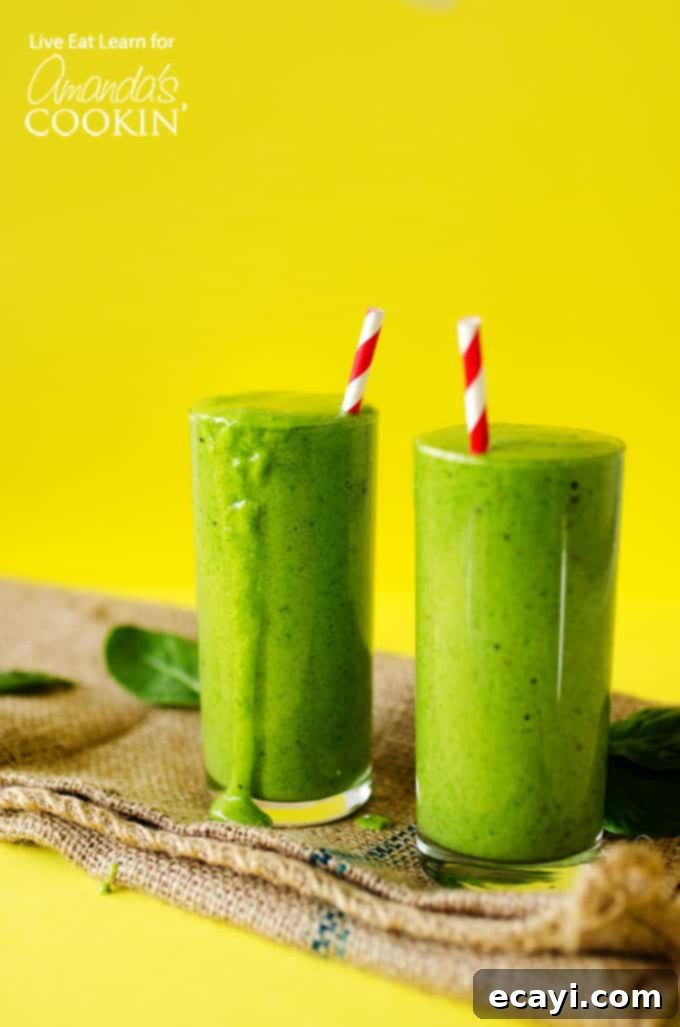
Why Embrace Green Smoothies? Your Daily Dose of Goodness Made Easy
Even for those of us who love healthy eating and understand nutrition, getting enough vegetables can sometimes feel like a challenge. The allure of sweet treats or the convenience of less healthy options often takes precedence over meticulously preparing a vegetable side dish.
This is precisely where green smoothies shine as a game-changer. They offer an effortless and delicious solution to incorporate a significant serving of vegetables into your diet, often without even tasting the “green.” These smoothies are typically ready in under 5 minutes, making them ideal for busy mornings or as a quick, nutritious pick-me-up. Beyond convenience, they provide sustained energy, helping you feel fuller and more focused throughout your morning, thanks to a powerful blend of fiber, vitamins, and minerals. They’re not just a drink; they’re a commitment to your health, easily integrated into any lifestyle.
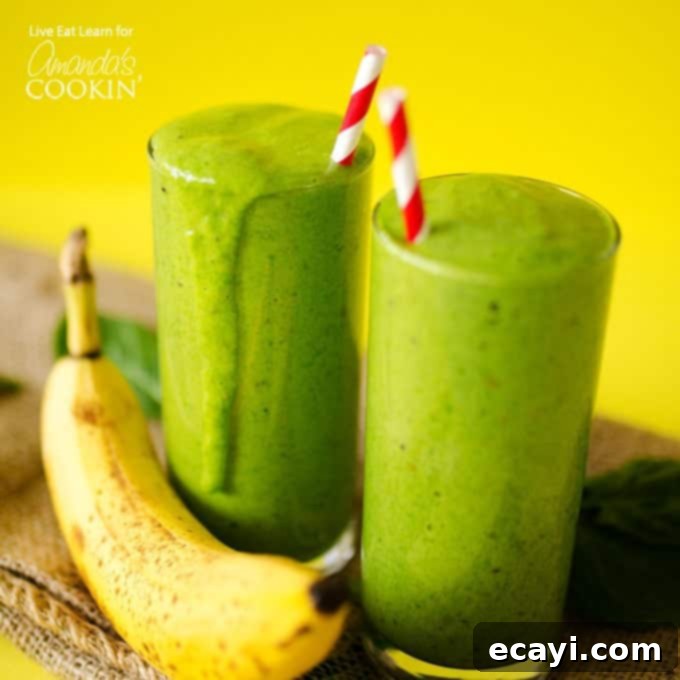
Crafting Your Perfect Green Smoothie: The Versatile Formula
The beauty of green smoothies lies in their flexibility. While we provide a fantastic basic recipe below, the core formula is highly adaptable, allowing you to use whatever ingredients you have on hand or prefer. Think of it as a template: a base of greens and liquid, a touch of fruit for sweetness, and optional boosters for added nutrition and flavor. For example, if you’re looking for a refreshing twist, try a Cucumber Tropical Smoothie. The possibilities are endless, and we’ll guide you through the best choices for each component.
Key Ingredients for Your Green Smoothie
Leafy Greens: The Core of Your Smoothie
The foundation of any great green smoothie is, of course, the greens! There are several excellent choices, each bringing its own unique nutritional profile and subtle flavor. For beginners, spinach is often recommended due to its very mild taste, which easily blends into almost any fruit combination without being overpowering. It’s packed with iron, vitamins K, A, and C, and essential antioxidants. Kale, on the other hand, is a nutrient powerhouse known for its robust flavor and high levels of vitamins, minerals, and potent antioxidants. If you’re new to kale in smoothies, start with a smaller amount and gradually increase it as your palate adjusts. Other fantastic options include Swiss chard, bok choy, romaine lettuce, collard greens, and even dandelion greens for a more detoxifying effect. Experiment to find your favorite!
Liquids: The Heart of Your Blend
Choosing the right liquid is crucial for both consistency and nutritional value. Water is the simplest and most calorie-free option, perfect for pure hydration and letting the flavors of your fruits and greens shine. For added creaminess, protein, and calcium, dairy milk or a non-dairy alternative like almond milk, soy milk, or coconut milk works wonderfully. Each non-dairy milk offers a slightly different taste and nutritional profile. Coconut water is an excellent choice for a natural electrolyte boost and a hint of tropical sweetness. While juice (like apple or orange) can be used, be mindful of its higher sugar content; opt for freshly squeezed options or use it sparingly to avoid excessive added sugars.
Fruits: Nature’s Sweeteners & Texture Enhancers
Fruits are essential for balancing the green flavor and adding natural sweetness, fiber, and an array of vitamins. Banana is a classic choice, providing a wonderfully creamy texture and a good source of potassium. For a thicker, colder smoothie, use frozen banana slices. Berries (strawberries, blueberries, raspberries) are rich in antioxidants and fiber, adding a delightful tartness. Tropical fruits like mango and pineapple offer natural enzymes and intense sweetness. Stone fruits such as peaches, cherries, or plums are excellent seasonal additions. Apples and pears contribute fiber and a subtle sweetness, while oranges provide a burst of Vitamin C. For an extra creamy boost and healthy fats, don’t shy away from adding avocado. Even grapes can be used for a refreshing, naturally sweet blend.
Creamy Bases & Boosters: Elevate Your Smoothie
Beyond bananas, other ingredients can provide a luxurious creamy texture and added nutrients. Yogurt (Greek or plain) is fantastic for probiotics and protein, making your smoothie more filling. If using yogurt, we often suggest omitting banana to prevent an overly thick or sweet consistency, as both contribute to creaminess. For extra healthy fats and a velvety texture, a quarter or half of an avocado works wonders. Nut butters like almond, cashew, or peanut butter can also add protein, healthy fats, and a delicious nutty flavor. Consider adding superfoods such as chia, flax, or hemp seeds for omega-3 fatty acids, fiber, and plant-based protein. For an extra nutritional punch, hemp protein powder or acai powder are great options. Enhance the flavor with pure extracts like vanilla or almond, a sprinkle of cinnamon for warmth and potential blood sugar benefits, or a spoonful of cocoa powder or cacao nibs for a chocolatey twist. A touch of fresh ginger can add a zesty, anti-inflammatory kick.
Frequently Asked Questions About Green Smoothies
There are several leafy green vegetables perfect for your green smoothie recipes. We highly recommend starting with spinach as it has a very mild flavor that blends seamlessly. Once you’re comfortable, you can explore other nutrient-dense options like kale (which has a slightly stronger taste), Swiss chard, bok choy, romaine lettuce, collard greens, and even more adventurous choices like dandelion greens. Remember to wash all greens thoroughly before blending!
The choice of liquid significantly impacts the flavor and consistency of your green smoothie. You can use plain water for a lighter, calorie-free blend. For added creaminess and nutrients, opt for cow’s milk, or plant-based alternatives like almond milk, soy milk, or coconut milk. Coconut water is another excellent option for its natural electrolytes and subtle sweetness. If you use fruit juice, be mindful of the added sugars; fresh, unsweetened juices are always preferable.
The beauty of green smoothies is how many fruits complement the greens! For a creamy base and natural sweetness, banana is a top pick, especially when frozen. All types of berries (strawberries, blueberries, raspberries) are fantastic for antioxidants and a tangy flavor. Tropical fruits like mango or pineapple add a vibrant taste. Don’t forget stone fruits like peaches, cherries, or plums when in season. Apples and pears offer a gentle sweetness and fiber, while oranges, avocado, and grapes can also be blended in for diverse flavors and textures.
Yes, absolutely! Adding yogurt (plain or Greek) can boost the protein content and contribute to a wonderfully creamy texture, along with beneficial probiotics. However, if you include yogurt, we often suggest not also using a banana. Both banana and yogurt serve as excellent creamy bases, and using both might make your smoothie overly thick or sweet, depending on your preference. Choose one for your primary creamy component.
Enhancing your green smoothie with superfoods and flavorings is a great way to customize it! For superfoods, definitely add chia, flax, or hemp seeds for omega-3s, fiber, and protein, or a scoop of hemp or acai powder. For flavorings, pure extracts like vanilla or almond can add a lovely aroma. Nut butters such as almond or cashew butter provide healthy fats and richness. For a decadent twist, consider cocoa powder or cacao nibs. A dash of cinnamon can add warmth and spice, and a piece of fresh ginger offers a refreshing zing.
Yes, preparing smoothies in advance and freezing them is a fantastic meal prep strategy! You can even make green smoothie popsicles for a healthy frozen treat. If you plan to drink your smoothie later, freezing and thawing require a little planning. Blend a batch of your favorite green smoothie, pour it into individual serving containers (leaving about an inch of headspace for expansion), and freeze. The night before you want to enjoy a smoothie, simply move it from the freezer to the refrigerator to thaw slowly. This method ensures you have a healthy breakfast or snack ready with minimal effort. Explore more tips for freezing smoothies here.
Green juice and green smoothies both offer excellent nutrition, but they differ in preparation and fiber content. Green juice is made by extracting the liquid from fruits and vegetables, leaving the pulp (and most of the fiber) behind. This can be done with a dedicated juicer, which makes pulp removal super easy. If you don’t have a juicer, you can still make green juice using a blender by blending ingredients thoroughly and then pushing the mixture through a fine-mesh sieve or nut milk bag to remove the pulp. Remember, the key difference is that smoothies retain all the beneficial fiber, while juices are more concentrated nutrient shots. Get a blender green juice recipe here.
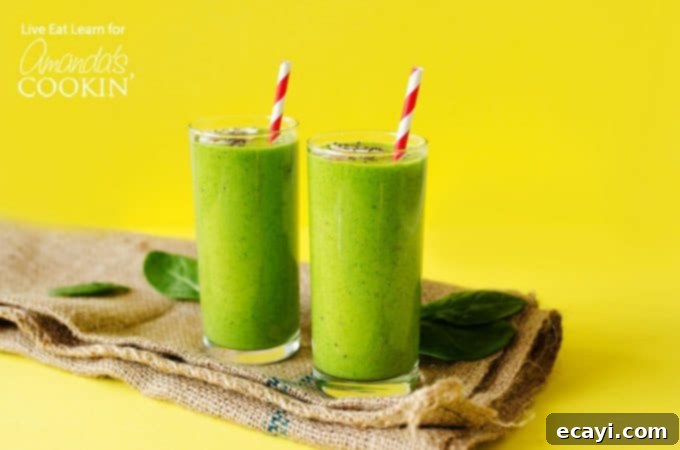
These vibrant, beautifully colored green smoothies are truly packed with delicious vegetables. Yes, you heard that right – delicious vegetables, blended into a naturally sweet and satisfying drink!
More Healthy & Delicious Smoothie Recipes to Explore
- Cranberry Detox Smoothie
- Cozy Coconut Smoothie
- Almond Maple Smoothie
- Cinnamon Roll Smoothie
- Strawberry Banana Smoothie
- Loaded Coffee Breakfast Smoothie
I love to create and share delightful recipes with you! To make sure you never miss out on new inspirations, I’ve made it easy with my weekly newsletter. You can subscribe for free and receive delicious recipes directly in your inbox every week.
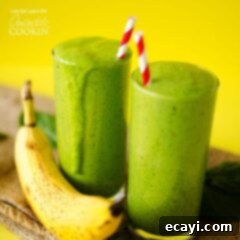
Green Smoothie Basics
IMPORTANT – For detailed information on ingredient choices and tips, please refer to the Frequently Asked Questions section earlier in this blog post.
Print It
Rate It
Save It
Saved!
Course:
Beverages
Cuisine:
American
2
5 minutes
210
Amanda Davis
Ingredients
-
1 cup milk or juice (dairy or non-dairy options) -
1 cup spinach or kale (fresh or frozen) -
½ cup banana (frozen for best texture) or ½ cup plain yogurt -
1 cup fruit (e.g., berries, mango, pineapple – frozen is ideal) -
1 Tbsp optional superfood topping (chia, flax, or hemp seeds for extra nutrients) -
1 tsp optional flavor enhancer (cinnamon, vanilla extract, a drizzle of honey or maple syrup)
Things You’ll Need
-
High-Speed Blender
-
Measuring cups and spoons
Expert Tips
- For a creamier smoothie, use frozen fruit (like banana or berries) or add half an avocado.
- Always blend your liquid and greens first until smooth before adding other ingredients to ensure no leafy chunks remain.
- Customize your smoothie with various fruits and optional superfoods like chia seeds, flax seeds, or protein powder for an extra nutritional boost.
Instructions
-
Pour your chosen liquid into a high-speed blender, followed by the leafy greens. Blend until the mixture is completely smooth, ensuring no green chunks remain.
-
Add the remaining ingredients: your chosen fruit, creamy base (banana or yogurt), and any optional superfood toppings or flavor enhancers.
-
Continue blending until all ingredients are well combined and the smoothie reaches your desired smooth consistency. Taste and adjust sweetness or thickness as needed.
-
Serve your fresh green smoothie immediately and enjoy a powerful start to your day!
Nutrition
Tried this Recipe? Pin it for Later!Follow on Pinterest @AmandasCookin or tag #AmandasCookin!
The recipes on this blog are tested with a conventional gas oven and gas stovetop. It’s important to note that some ovens, especially as they age, can cook and bake inconsistently. Using an inexpensive oven thermometer can assure you that your oven is truly heating to the proper temperature. If you use a toaster oven or countertop oven, please keep in mind that they may not distribute heat the same as a conventional full sized oven and you may need to adjust your cooking/baking times. In the case of recipes made with a pressure cooker, air fryer, slow cooker, or other appliance, a link to the appliances we use is listed within each respective recipe. For baking recipes where measurements are given by weight, please note that results may not be the same if cups are used instead, and we can’t guarantee success with that method.
This post originally appeared here on Mar 6, 2017.
